Environmental Investigation Agency (EIA) participated at the 36th Open-ended Working Group (OEWG) of the Parties to the Montreal Protocol in Paris on July 20-24. In this context, EIA campaigners prepared a report analysing the current amendment proposals for an HFC phase-down, which will help climate negotiations in Dubai in November. It also has great relevance […]
Environmental Investigation Agency (EIA) participated at the 36th Open-ended Working Group (OEWG) of the Parties to the Montreal Protocol in Paris on July 20-24. In this context, EIA campaigners prepared a report analysing the current amendment proposals for an HFC phase-down, which will help climate negotiations in Dubai in November. It also has great relevance to the Conference of Parties (COP21) which will take place in Paris in December. We bring you the report.

INTRODUCTION
Parties to the Montreal Protocol have a vital role to play in the greatest challenge of our time – climate change. In the build up to the Climate Change Conference in Paris in December 2015, the Montreal Protocol can provide critical momentum for the climate negotiations under the United Nations Framework Convention on Climate Change (UNFCCC) by reaching agreement this November at the 27th Meeting of the Parties to the Montreal Protocol in Dubai (27th MoP), to regulate the production and consumption of hydro fluorocarbons (HFCs) under the Montreal Protocol.
HFCs are included among the seven greenhouse gases (GHG) targeted by the UNFCCC, but are primarily used as replacements for ozone-depleting substances (ODS), controlled under the Montreal Protocol. Despite their ostensible regulation under the Kyoto Protocol, over the past 25 years, HFC emissions have grown from essentially non-existent to nearly two per cent of all GHGs. Emissions of HFCs continue to grow faster than any other GHG, and their growth is predicted to accelerate in the future.1 The Parties to the Montreal Protocol have a unique opportunity to lead the global community in the fight against climate change by taking responsibility for the production and consumption of HFCs.
At the 36th Open-ended Working Group (OEWG), Parties had four amendment proposals to consider, offering a diverse range of options to phase down the production and consumption of HFCs.2 Together with the Conference Room Paper submitted by the Africa States at the 35th OEWG,3 these proposals have been submitted on behalf of 95 governments representing approximately 3.5 billion people – roughly half the world’s population.
The proposals build on previous proposals and numerous declarations from the Parties urging action on HFCs under the Montreal Protocol.4 They have been buttressed by workshops and reports from the Technical and Economic Assessment Panel (TEAP) reaffirming that technically proven, environmentally sound and cost-effective alternatives to HFCs exist in most sectors, and are available to the Parties in order to replace HFCs.5 If an ambitious amendment is adopted swiftly, it could prevent the consumption of more than 100 billion tonnes of carbon dioxide equivalent (CO2e) HFCs by 2050,6 providing 10 times more climate mitigation than the Kyoto Protocol achieved from 1990-2012.
Core elements of an HFC phase-down
In addition to finance and technology transfer, which are at the heart of the Montreal Protocol’s success, historically there have been three core elements of production and consumption phase-outs under the Montreal Protocol, namely, the baseline, reduction schedule and grace period for Parties operating under Article 5 (“A5 Parties”). An additional element of importance is the final step of the reduction schedule, since all amendment proposals to date are proposing a phase-down, and not a phase-out, of HFCs.
Baseline
Although the reference years and percentages are different, all four proposals use some combination of HFCs and hydrochlorofluorocarbons (HCFCs) to calculate the baseline (on a CO2e basis). For Parties not operating under Article 5 (“non-A5 Parties”), there is convergence on a methodology that relies on recent HFC production and consumption, coupled with some percentage of HCFCs and the starting points are similar. For A5 Parties, the methodologies applied to the baseline vary more widely. Current HFC consumption in A5 Parties is estimated by TEAP to be approximately 705 million tonnes (Mt) CO2e. According to EIA’s calculations, the baselines in the four proposals range from 846 Mt CO2e in the North America (NA) Proposal to over 2,400 Mt CO2e in the India Proposal, a more than three-fold increase in HFC consumption. Parties should avoid setting the baseline too high in order to prevent unnecessary growth in HFC production and consumption in advance of the reduction schedule.
Reduction schedule
Since the first HFC amendment proposals were made in 2009, significantly more information is now available to the Parties to inform their consideration of reduction schedules. For both non-A5 and A5 Parties, TEAP has outlined a number of mitigation scenarios, the scenarios for non-A5 Parties being particularly conservative.8 Indeed, the European Union (EU) has already adopted an HFC phase-down for its 28 Member States that is far more ambitious than TEAP’s MIT-2 scenario for non-A5 Parties.9 TEAP’s MIT-3 scenario for A5 Parties is challenging, but achievable with a large-scale transition to currently available low-GWP technologies in new equipment.
It should be noted, however, that a transition to GWP 300 in place of truly low-GWP alternatives will ultimately result in resumed growth of HFC consumption (in CO2e terms) over time due to the growth in demand for refrigeration and air-conditioning (AC) in A5 Parties.10
Grace period
Throughout the history of the Montreal Protocol, non-A5 Parties have implemented control measures to reduce their production and consumption of controlled substances in advance of A5 Parties. This grace period is one way in which the Montreal Protocol implements the principle of common but differentiated responsibilities, the rationale being to allow time for replacement technologies to develop before being transferred to A5 Parties. In the past, however, the long grace period often meant that A5 Parties were offered outdated and unsustainable technologies no longer in demand in non-A5 Parties. Since A5 Parties are still primarily relying on HCFCs, there is an opportunity for A5 Parties to ‘leapfrog’ dead-end HFC technologies and undertake a one-time transition from HCFCs to low-GWP alternatives. To do this, the grace period needs to be limited in order to prevent a massive growth in the uptake of HFC technologies in A5 Parties concomitant with the HCFC phase-out. In addition, it is necessary to implement an early HFC phase-down in non-A5 Parties that expands the commercialisation and market penetration of low-GWP technologies, to allow for their swift adoption in A5 Parties at reduced costs.
COMPARISON OF PROPOSED HFC AMENDMENTS
Proposals for non-A5 Parties
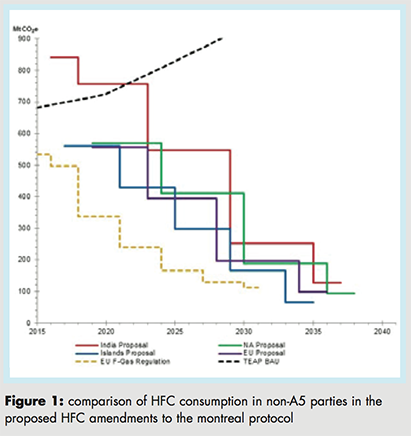
Using HFC consumption data from the June 2015 TEAP report Decision XXXVI/9 Task Force Report – Additional Information on Alternatives to Ozone-Depleting Substances and HCFC consumption data from the Ozone Secretariat website,11 EIA has analysed the four proposals submitted by: Canada, Mexico and the United States (the “North America proposal” or EU proposal”); and from India (the “India proposal”).
Figure 1 compares HFC consumption in the four proposed non-A5 Parties’ reduction schedules and includes the 2014 EU F-Gas Regulation as a frame of reference. Table 1 outlines the basic components of the four proposals and cumulative HFC consumption reductions from 2015-2040, based upon TEAP business-as-usual (BAU) data extrapolated to 2040.12
As Figure 1 shows, the proposed level of ambition for non-A5 Parties is lower than unilateral measures already being implemented in these countries. In April 2014, the EU and its 28 Member States, which together constitute a majority of non-Article 5 Parties, adopted the EU as Regulation, which sets out to achieve a 79% reduction in HFC consumption by 2030 from current levels. The reduction schedule was based on a thorough technical analysis that determined the swift adoption of safe and cost-effective alternatives, in particular natural refrigerants, was feasible.13 Translated to all non-A5 Parties, the EU F-Gas Regulation would result in a reduction of more than 17.8 GtCO2e in HFC consumption during the 2015-2040 period.
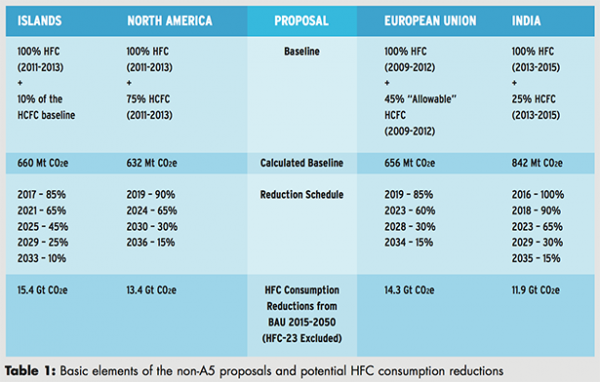 In addition, it is unclear why all four proposals include a significant HCFC component in the baseline, in particular the EU and India proposals. Allowable HCFC consumption for non-A5 Parties is currently just 10% of the baseline, although many countries have already achieved complete phase-out.
In addition, it is unclear why all four proposals include a significant HCFC component in the baseline, in particular the EU and India proposals. Allowable HCFC consumption for non-A5 Parties is currently just 10% of the baseline, although many countries have already achieved complete phase-out.
Given that all non-A5 Parties recognise the need to reduce HFC emissions, the assumption that all remaining HCFC use will transition to HFCs (and is, therefore, required in the baseline) is misguided. Most, if not all, current HCFC consumption in non-A5 Parties is dedicated to servicing installed equipment, which should not be replaced with high-GWP HFCs at end-of-life.
Recommendations for non-A5 Parties:
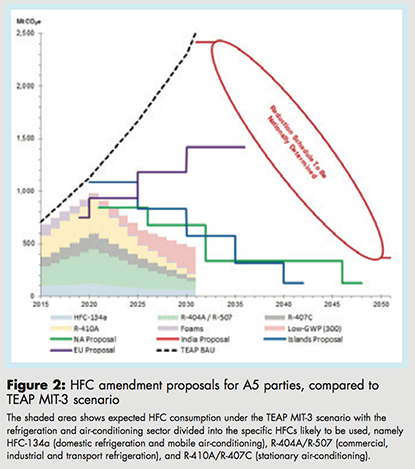
Proposals for A5 parties
Figure 2 compares the four proposed A5 Parties’ schedules against the new MIT-3 scenario outlined in the June 2015 TEAP report. According to TEAP, MIT-3 assumes that bans on the use of certain high-GWP chemicals enter into force in new manufacturing as of 2020, with an average GWP of replacement refrigerants of 300 for both the commercial refrigeration and the stationary AC sectors. The scenario assumes a six-year manufacturing conversion period and HFC consumption data are only available from TEAP up to 2030. Data provided for foams is also taken into account, based on previous TEAP assessments.14
The EU proposal differs significantly from the other amendment proposals for A5 Parties, as it envisages a freeze of the combined climate impacts of HFC and HCFC consumption (that is, on a CO2e basis), while maintaining the existing HCFC phase-out schedule. This means that as HCFCs are phased out, there is room for a certain amount of HFC growth up to the combined freeze level. For the purposes of the graph, the EU proposal assumes that HCFCs are phased out strictly according to the schedule.
As can be seen in Figure 2, all four proposals are achievable under the MIT-3 scenario as far as 2030 (the date to which TEAP modelled MIT-3).
The Islands and North America proposals put forward steps that are close to the MIT-3 scenario, while the EU and India proposals are much closer to the BAU scenario. Both the EU and India proposals rely on the future establishment of a reduction schedule for the HFC phase-down, with the EU proposal requiring Parties to agree a schedule by 2020 and the India proposal allowing A5 Parties to determine national steps five years in advance of each five-year period. To the extent reduction schedules are to be established at a future date, those reductions schedules should be governed by criteria on technical feasibility as well as cost-effectiveness considerations, with the primary objective being to minimise HFC emissions. EIA does not support nationally determined steps, as it would add considerable complexity for the implementation of the phase-down under the Multilateral Fund (MLF) and uncertainty in terms of consumption reductions and costs. Substantial flexibility on a national level already exists under the process of national phase-out management plans (HPMP).
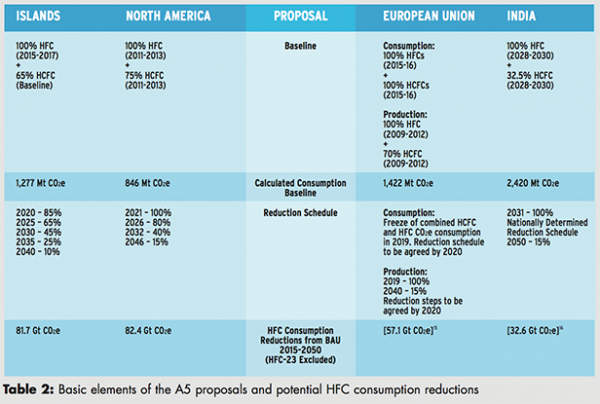
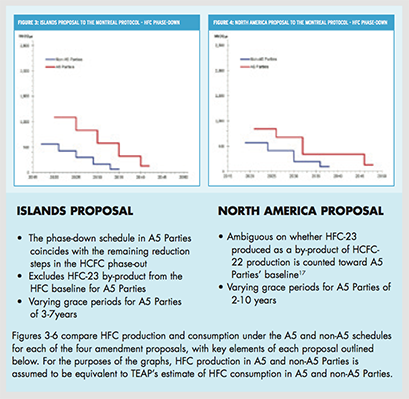 The four proposals contain large variations in the grace period offered to A5 Parties, ranging from two to 15 years. Given the proliferation of low-GWP technologies, A5 Parties are in the position to jump directly to low-GWP technologies, such as natural refrigerants, in almost all sectors. A short grace period will enable A5 Parties to capitalise on this opportunity, rather than transitioning to high-GWP HFCs that will entail a second costly transition further down the road. Opportunities to leapfrog HFCs can be maximised by aligning the HFC phase-down with the HCFC phase-out reduction targets (that is, in 2020, 2025 and 2030) so that a coordinated sectoral approach within the MLF can be taken.
The four proposals contain large variations in the grace period offered to A5 Parties, ranging from two to 15 years. Given the proliferation of low-GWP technologies, A5 Parties are in the position to jump directly to low-GWP technologies, such as natural refrigerants, in almost all sectors. A short grace period will enable A5 Parties to capitalise on this opportunity, rather than transitioning to high-GWP HFCs that will entail a second costly transition further down the road. Opportunities to leapfrog HFCs can be maximised by aligning the HFC phase-down with the HCFC phase-out reduction targets (that is, in 2020, 2025 and 2030) so that a coordinated sectoral approach within the MLF can be taken.
EIA urges Parties to ensure that HFC production is phased down in line with HFC consumption to avoid exacerbating illegal trade. TEAP should consider in more detail the proportion of HFC production that is located in A5 and non-A5 Parties, and whether differentiated schedules will result in total HFC production being reduced in line with total HFC consumption.
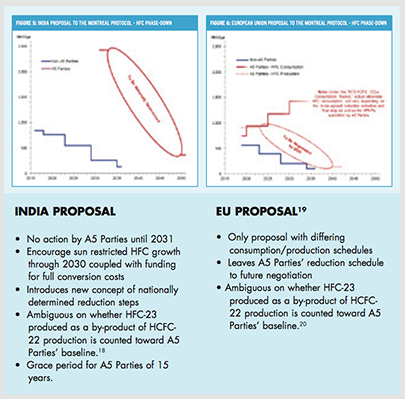 Recommendations for A5 Parties:
Recommendations for A5 Parties:
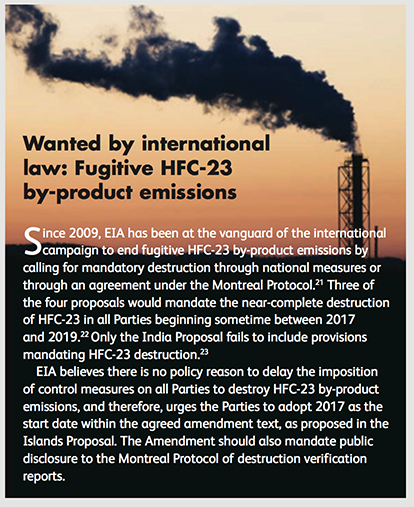 CONSIDERATION OF EXEMPTIONS
CONSIDERATION OF EXEMPTIONS
Some Parties have put forward the concepts of essential use nominations and “exceptional measures” as a response to concerns that low-GWP alternatives to HFCs will not be available in all sectors and for all Parties as needed, particularly countries with high-ambient temperature conditions. While both of these concepts have been utilised by the Montreal Protocol, other tools are available to alleviate these concerns and it is not necessary to include such measures within the adopted amendment at this time.24
TEAP’s most recent reports have made clear that technically proven, environmentally sound and cost-effective low-GWP alternatives to HFCs have been commercialised in most sectors.25 This contrasts sharply with the lack of available alternatives to CFCs in nearly every sector at the time the Montreal Protocol was agreed in 1987 that led to the inclusion of an exemption process within the CFC phase out.26
In addition, the proposed control measures for HFCs are a phase-down, not a phase-out, with all four proposals anticipating some HFC use indefinitely into the future, varying from 10 to 15% of the baseline. In practice, this portion of the HFC baseline is a built-in exemption that is larger than the essential-use exemptions relied upon by Parties during the CFC phase out.27
It is also possible for Parties to take a “wait and see” approach and address the issue of essential use exemptions as the HFC phase-down progresses, as was done with the accelerated HCFC phase-out agreement.28 In this way, the Parties will not stifle technological progress by relieving the regulatory pressure of the Montreal Protocol, which has almost always resulted in alternatives being made available before the Parties needed to resort to an exemption process.
For these reasons, EIA urges the Parties to adopt an amendment that does not contain essential use exemptions or exceptional measures at this time, but leaves the issue open for discussion in the future.
FUNDING THE FUTURE
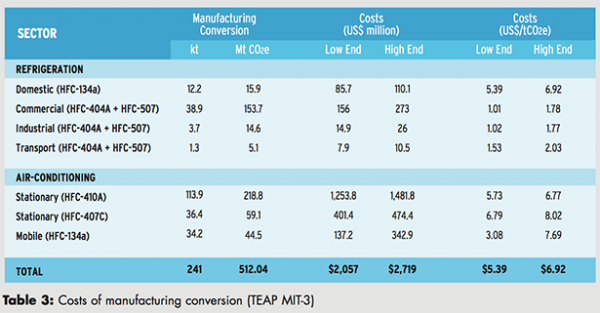
The MLF is the most successful global environmental financial mechanism in history, and has effectively implemented the principle of common but differentiated responsibilities. However, new challenges that will result from the Montreal Protocol tackling HFCs will require innovative improvements to the financial mechanism to maximise the climate benefits of an HFC phase-down.
Given the MLF’s track record of success, EIA believes that changes to Article 10 of the Protocol should be approached with caution. For example, in EIA’s view, the changes put forward in the India proposal would greatly increase the funding required of the MLF the environmental benefits delivered. However, with the incorporation of climate considerations under the Montreal Protocol, Parties should adapt the MLF to promote energy-efficient solutions. Addressing energy efficiency in refrigeration and air conditioning equipment can double CO2e emissions savings resulting from an HFC phase-down.29
In addition, Parties should request the Executive Committee of the MLF to review its existing policies and procedures to determine how to provide additional incentives for and remove barriers to the uptake of low-GWP and not-in-kind HFC-free technologies. Training and capacity-building to ensure safe handling of natural refrigerants, the revision of antiquated standards and codes and adequate pilot and demonstration projects also need to be fully addressed, particularly in the servicing sector.30
EIA also believes it is in the best interest of all Parties and the climate to provide financial and technical support to those Article 5 Parties seeking to reduce their HFC production and consumption in advance of the phase-down schedule. Forty countries proposed to transition from HCFCs to low-GWP alternatives faster than the reduction schedule in Stage 1 of the HCFC phase-out. An HFC Amendment should be able to accommodate the desire of A5 Parties to achieve a transition to low-GWP alternatives in a single step through the HCFC phase-out. By leapfrogging high-GWP HFCs and through an early transition into no- and low-GWP alternatives, donor countries will decrease the cost of financial assistance through the MLF in the long term, while providing much-needed additional climate mitigation in the short term.
In its June 2015 report, TEAP provides cost estimates for the MIT-3 scenario, assuming a six-year manufacturing conversion (see Table 3).31 According to TEAP, approximately 241,038 tonnes of refrigerant require conversion in the manufacturing sector at an estimated total cost of USD 2-2.7 billion, which spread over six years, would mean an amount of USD1,200 ± 170 million per triennium.32 Considering the GWP of the refrigerants concerned, this results in costs per CO2 tonne ranging between USD 1 and USD 8, representing extremely cost-effective climate mitigation. The cost effectiveness of reducing HFC emissions, per CO2 tonne, will become still more cost-effective when combined with HFC emissions reductions from the servicing sector.
CONCLUSION
The growing number of governments submitting amendment proposals and conference room papers in 2015 is indicative of the growing sentiment among the Parties to the Montreal Protocol that the time has come to control HFCs. Moreover, outside of the Montreal Protocol, world leaders have repeatedly called for an HFC phase-down under the Montreal Protocol. The international chorus of countries can no longer be ignored. The Parties must give proper consideration in a contact group formed at the 36th OEWG to lay the groundwork for the adoption of an amendment at the 27th MoP.
Report courtesy: EIA, an independent campaigning organisation committed to bringing about change that protects the natural world from environmental crime and abuse.
No part of this publication may be reproduced in any form or by any means without permission in writing from the Environmental Investigation Agency. This report was produced by the London and Washington, D.C. offices of the Environmental Investigation Agency (EIA). EIA is solely and entirely responsible for the contents of this report.
© Environmental Investigation Agency 2015
CPI Industry accepts no liability for the views or opinions expressed in this column, or for the consequences of any actions taken on the basis of the information provided here.
Copyright © 2006-2025 - CPI Industry. All rights reserved.